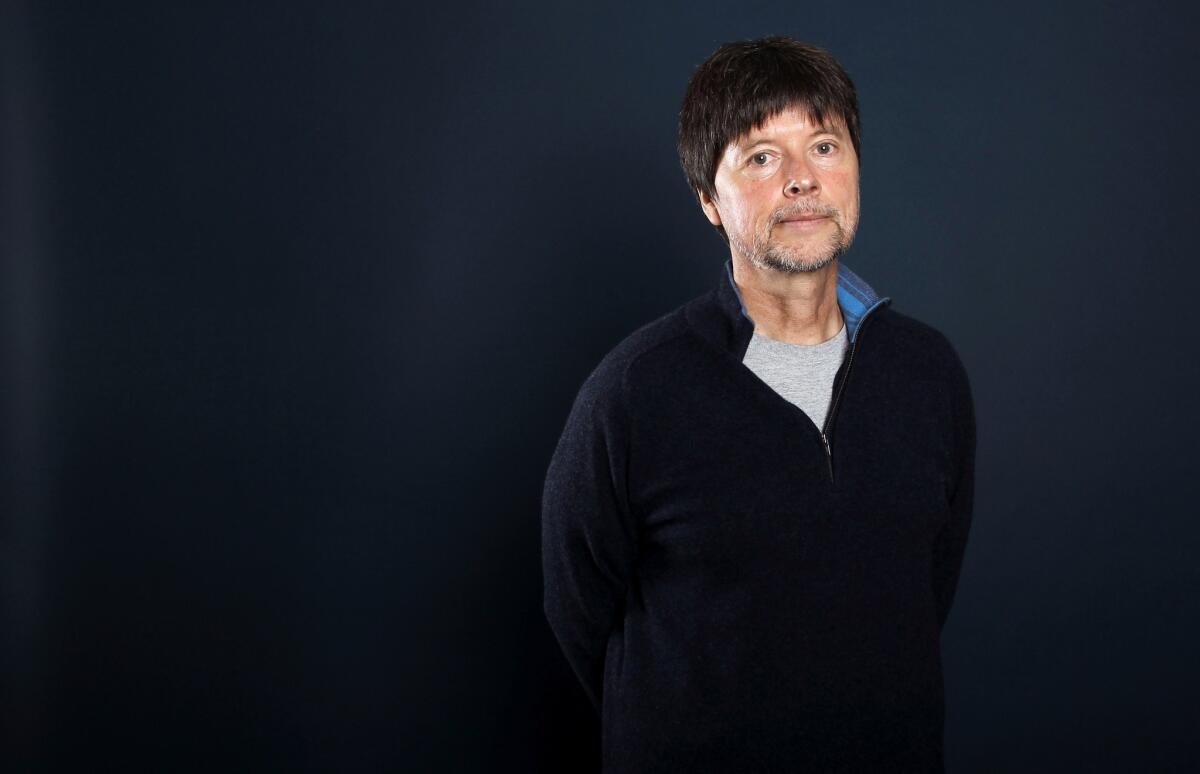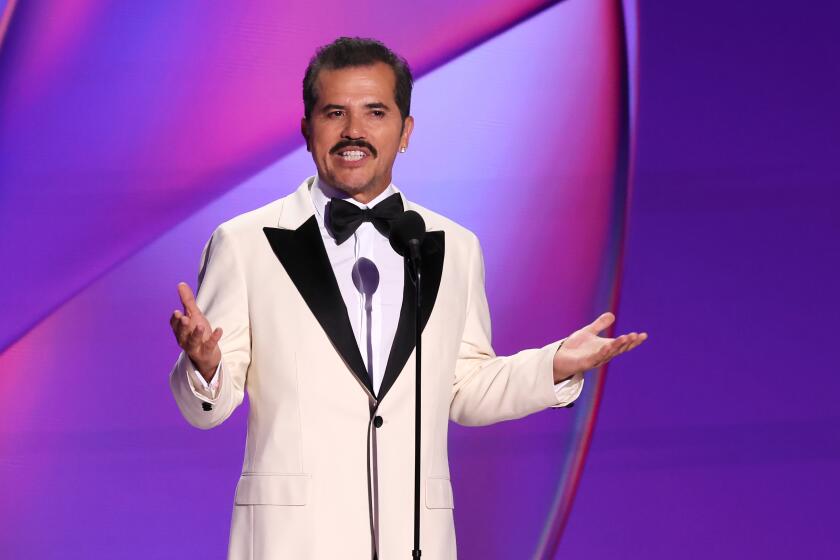Docuseries are the hottest thing on TV. Someone should tell the Emmys
- Share via
By any measure, “The Last Dance” is one of the most successful TV shows of the last year, the kind of must-watch appointment programming that has become increasingly endangered in an era of fragmented audiences and on-demand streaming. The 10-part docuseries revisits the heyday of Michael Jordan and the Chicago Bulls and includes a trove of previously unseen behind-the-scenes footage of the 1997-98 season.
Airing on ESPN last spring when there were no professional sports to watch and few recreational outlets besides TV, the series tapped into the potent strain of ’90s nostalgia and painted a complicated portrait of a celebrity who was, at his peak, one of the most famous and beloved people on the planet.
Viewers, it seemed, couldn’t get enough; “The Last Dance” averaged 5.8 million live viewers an episode, a number that more than doubled to 12.8 million with time-shifted viewing. It was the highest-rated program across all of broadcast or cable TV on the five consecutive Sundays it aired, and it is one of the most popular shows on Netflix, where it began streaming July 19.
“The Last Dance” is just one of several documentary series to break out over the last year. The gripping Netflix series “Cheer” followed the cheerleading team at a Texas junior college over the course of a punishing season. Another Netflix title, “Tiger King,” told the unbelievable true story of an Oklahoma zookeeper named Joe Exotic and his cutthroat rivalry with another big-cat fanatic.
The wildly entertaining “McMillions” on HBO revisited a mostly forgotten scam involving the McDonald’s Monopoly game. Ken Burns, who helped pioneer the long-form TV documentary, had his biggest success in years with the 16-hour “Country Music” on PBS. While these shows vary wildly in style and subject, they all struck a chord with viewers.
ESPN and Netflix’s docuseries “The Last Dance,” about Michael Jordan and the Chicago Bulls, is ambitious sports storytelling at a moment we’re aching for it.
“Any good sports story, any good political story, any good news story contains characters that are compelling and who you want to come back to, to watch again and again,” says Jason Hehir, director of “The Last Dance” and an avid viewer of long-form documentaries such as “The Staircase.” “The audience is always going to respond to great characters, especially great characters who the filmmaker can make you reconsider as the story unfolds. You may think the Tiger King is one thing at the beginning of the series and by the end you have a much different view of him — same with Michael Jordan and so many of the characters that inhabit these series. It’s like a great book. We’ve all had that feeling when we finish a great book, and we’re sad to be on that last page.”
But should any of them receive Emmy nominations Tuesday — which seems likely — they won’t be honored at the Primetime Emmy Awards in September. That’s because the Television Academy has not kept pace with the viewing public when it comes to the popularity of docuseries. Not only are the documentary awards handed out at the less-watched Creative Arts Emmys, but the Emmy categories also do not reflect the increasingly rich array of nonfiction storytelling available in the era of Peak TV.
Burns has been making documentary series since “The Civil War” was a hit for PBS 30 years ago, and he cites “The World at War” and “Victory at Sea” — originally broadcast in the 1950s — as early inspirations for his interest in the medium. While the filmmaker resists the idea there is anything particularly new about episodic, long-form documentaries, he says the appetite for them has increased in the current media climate.
“What we have are circumstances, not just over the last four months but over the last four years, that require facts, that require truth. In a funny way, fiction is sometimes inadequate. I think, right now, you can’t make this [stuff] up,” he says. “There is an urgency [for fact] right now, which I think helps drive the demand.”
2015 marked a discernible tipping point for the genre, with the release of “The Jinx” on HBO and “Making a Murderer” on Netflix. Coming on the heels of the hit podcast “Serial,” both shows ignited interest in true crime documentaries and empowered audience members to become armchair detectives. The following year came “O.J.: Made in America,” a seven-hour epic that reconsidered O.J. Simpson and his media-spectacle murder trial through the lens of race, class and celebrity in America.
Netflix docuseries ‘Cheer’ has turned the Navarro College cheerleaders and their no-nonsense coach into reality stars.

Since then, viewers have gotten hooked on numerous other long-form documentaries telling labyrinthine real-life stories that would seem too implausible had they been concocted by Hollywood screenwriters: “The Keepers,” “Wild Wild Country” and “Leaving Neverland” to name a few recent examples. The rise of the docuseries has brought long-form nonfiction storytelling — once thought of as a bookish niche for the PBS set — to millions of viewers unlikely to know the difference between the Maysles brothers and Mrs. Maisel.
“Audiences became aware that documentaries could be a fun ride or even a wild ride. It wasn’t going to be something you only do because you’re eating your vegetables,” says Jessica Dimmock, codirector of the Netflix series “Flint Town.” She praises character-driven shows such as “Last Chance U” and “Cheer” that “made us realize that real people are really interesting and really lovely, and if you follow them for a while you’ll get invested in them, and you want to see what happens.” As a documentary filmmaker, she says she has witnessed firsthand the growing appetite for documentary storytelling in TV: “If you have access to a good story and the desire to make something, you can find a home for it.”
“Tiger King” may be the ultimate example of the bonkers, stranger-than-fiction documentaries that viewers can’t resist. Directed by Eric Goode and Rebecca Chaiklin, the seven-episode series delved into the bizarre world of big-cat enthusiasts. According to Netflix, which releases selective audience information, 64 million households globally watched some of the series in its first month of release. (Nielsen estimates 34 million people watched it in its first 10 days of release.)
While it may or may not be Emmy worthy — the filmmakers have been accused of treating Exotic with too much sympathy — “Tiger King” is the kind of broadly popular show that, if nominated, could potentially attract new viewers at a time when awards show ratings are flagging.
The co-directors of the wild Netflix docuseries “Tiger King” discuss Joe Exotic, the series’ animal rights message and the reaction from fans.
The Academy of Television Arts and Sciences recognizes documentaries in a number of categories that are hazily defined and do not make meaningful distinctions among styles of nonfiction storytelling or recognize the breadth, variety and ambition of TV documentaries. The awards are also given out during the Creative Arts Emmys, which are part of a separate telecast that will air this year on FXX.
Outstanding documentary or nonfiction series recognizes both ongoing shows (“Chef’s Table”), multi-episode, single-season documentaries (“Wild Wild Country” won in 2018) and series that present multiple films under a single banner, such as “30 for 30” or “American Masters” (both nominated last year).
Outstanding documentary or nonfiction special honors films and one-off specials but also includes films presented in multiple parts — or what the rest of us call series. (HBO’s “Leaving Neverland” won the category last year.)
A third prize, exceptional merit in documentary filmmaking, is a juried award primarily given to films but will also sometimes recognize documentaries “that tell a single ‘story’ but are broken up into multiple parts,” according to a spokesperson for the TV Academy. (There are also categories for writing, directing, editing and sound editing for nonfiction programming.)
There is no specific category dedicated to what might be defined as the limited docuseries — single-season series that tell a unified story over multiple episodes. And unlike in the reality TV categories, which distinguish between structured and unstructured reality shows, there’s no distinction made between styles of nonfiction filmmaking, so that a historical documentary, a fly-on-the-wall narrative and a travelogue might be competing against one another in a single category.
The TV Academy says that while it regularly reevaluates Emmy categories, there is no discussion of splitting single-season documentaries from ongoing docuseries. It also does not see a difference between Emmys given during out during the Creative Arts ceremonies and those given during the network telecast, which are dictated by the so-called wheel agreement between the networks and the TV Academy. “They are all equally prestigious, and they all honor the best in television,” the spokesperson said.
Documentary filmmakers — who’ve complained about the Oscars since “Hoop Dreams” was snubbed a quarter century ago — are used to Hollywood not quite getting what they do, and even popular success isn’t going to change that overnight.
“I learned long ago to not place any kind of faith that the Emmys were going to pick the best documentary,” says Burns. His 18-hour magnum opus “The Vietnam War,” a decade in the making, was overlooked in the documentary series category entirely and lost the documentary sound editing prize to “Anthony Bourdain: Parts Unknown,” whose popular host had just died.
Members of the TV Academy “just don’t know how to handle documentaries,” he adds. “We shouldn’t be in the same category as Anthony Bourdain to begin with. But I long ago told my colleagues, ‘Don’t fly out there, don’t do this, you will be disappointed.’ We’ve won a ton of Emmys. But it will drive you crazy because it’s so capricious.”
More to Read
The complete guide to home viewing
Get Screen Gab for everything about the TV shows and streaming movies everyone’s talking about.
You may occasionally receive promotional content from the Los Angeles Times.







